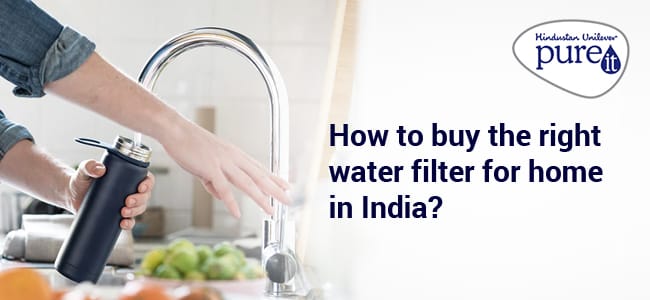
Do you know why water purifiers are essential for homes? It is because clean drinking water is essential for every human being, but not all people have access to it. There is a lot of water scarcity in many parts of India, and people of those regions mostly have to depend on groundwater or water supplied through tankers. The quality from such sources is not good because of the contaminants that are present, like pesticides, heavy metals, bacteria, cysts, and high TDS or Total Dissolved Solids. This is why many people are turning towards water filters for home in order to purify the drinking water.
If you are looking for a purifier, then it is easy to get overwhelmed by the sheer number of brands and models available in the market.
Here are some tips on choosing a water purifier:
You must know the source and quality, like hardness, salinity, and TDS of the water, before buying a purifier.
What is TDS, and how much of it is acceptable for drinking?
Total Dissolved Solids or TDS is used to describe the inorganic salts and small amounts of organic matter present in the water. Usually, TDS consists of magnesium, calcium, sodium, potassium cations, carbonate, hydrogen carbonate, sulfate, chloride, and nitrate anions. It is measured in mg/liter or ppm (parts per million).
If the TDS of tap water is below 200ppm, it is considered of drinkable quality. However, you might still need to purify it in order to remove all the harmful bacteria and viruses.
Different types of water purifiers:
Usually, there are three main types of water purifier which are used at home like RO (Reverse Osmosis), UF (Ultrafiltration), and UV (Ultraviolet). Sometimes water filters use a combination of multiple technologies like RO and UV. According to your TDS level, you have to choose the type of water filter which suits your need.
- a) RO Water Purifiers
In an RO water purifier, a pump pushes the water at high pressure into an RO chamber that has a semipermeable membrane with pores in approximately 0.0001 microns. When the water molecule passes through the other side, it leaves all the dissolved solids and impurities. The impure or contaminated water is being discharged through a separate outlet which is known as a reject line.
Except for an RO membrane, other elements are being used to better filtration and increase an RO membrane’s life. These filters are known as ‘Stages’. In an RO, the process of filtration starts from Sediment Filter which is the first filter and helps to remove all the suspended impurities from the water. After that, it passes to Activated Carbon Block, the second filter that helps to remove chlorine, bad odor, and adsorb pigments. After the filtration from the RO membrane, the water is pushed through a post-carbon filter which helps to improve the taste of the drinking water.
RO is among the most effective form of water purification method which requires electricity and water wastage. So if you receive water that has a TDS level of less than 200ppm, you might not need an RO water purifier as it can be expensive, waste a lot of water, need electricity, and even has high maintenance costs. However, many brands have recently started offering purifiers that have a separate tank to store discharged water that can later be used for other activities like clothes, utensils, or wipes the floor. Before settling, do compare water filter prices online as well as offline if you have a budget.
- b) Gravity-Based Water Purifiers
Gravity-based Water Purifiers works without electricity as it mainly uses the gravitational force to push the water down through a membrane or filtration process. There are various gravity filters like Carbon block, UF, Ceramic Block, and Non-Woven Media. They can help to remove chlorine, cysts, dust, large and un-dissolved solids.
- c) UV Water Purifiers
UV purifiers generally use an ultraviolet lamp that is effective in neutralizing bacteria and viruses. These purifiers offer the process of fast filtration, as they can’t remove dissolved solids and chemicals from the water. But, you have to replace the UV lamp every six months or a year as the intensity keeps on reducing.
Here are some factors that you must consider before buying a water purifier for your home:
- Water Quality: As mentioned repeatedly by experts, you must check for water quality before buying a purifier. If the area you are staying with has a high level of TDS, hardness, and salinity, you must opt for an RO purifier. It helps in removing the tiniest of dissolved salt, metals, and impurities.
- Contamination: Some of the common contaminants found in the water are bacteria, nitrate, dissolved pesticides, and lead. However, the amount present can be tested, and if the tap water at your home has a high level of microbes and contaminants, you need to install RO+UV+UF filters.
- Storage Capacity: When you are buying a purifier, it is important to consider the storage capacity. If you live in an area prone to a lot of power cuts, you need a purifier that has a higher storage capacity.
- Certifications: Reviews and certifications are other important factors that you must check before buying a water purifier. Remember that a certified water purifier ensures brand authenticity and trustworthiness.
Hello, I am a professional writer and blogger at Adclays.com. I love to explore the latest topics and write on those topics. I spend the maximum of my time on reading and writing interesting topics which provide valuable piece of information to my readers whether it comes to the latest fashion, technology, healthy lifestyle, business information, etc. Explore my writings by visiting the website.